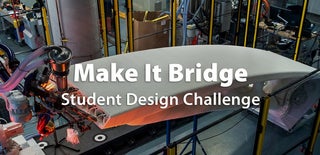Introduction: Canal Pedestrian Bridge
My name is Emma. I am a 17 year old Senior in Gilbert, AZ. I am going to be taking welding / manufacturing this year and I really hope to be able to build my design for real. I designed a bridge to connect my neighborhood to the pedestrian road next to the canal. Many people enjoy access to the canal road for exercise, fishing or just connecting with friends. Unfortunately, my neighborhood does not have access without a mile detour down to the next major road. Creating this bridge would make connecting with nature and people on the other side much faster and safer.
Supplies
Scaniverse photogrammetry app on iPhone
Tinkercad to design the bridge
Instant Meshes retopolgy app to simplify mesh
Blender to fix 3D model of terrain
Unity to export a video
Step 1: Photogrammetry Measurements
I used Scaniverse photogrammetry software to make a model of the area where I would place the bridge. Thankfully, they had drained the canal for maintenance, making it easier to cross and make more accurate measurements for the model of the terrain that my bridge would be in. As seen in the image, the distance is just over 8 meters and Scaniverse really only works up to 5 meters.
The app is fairly straight forward. After starting a scan, you move the phone around what you want to scan until the candy stripe texture is gone from what you are scanning. After scanning, you can process the model as an "Area". Once the 3D model is created, you can load it and tap the "Measure" button to find the distance between points on the model.
(Optional) After getting the measurement for the span of the canal, I tapped the "Share" button to send the model (as an 'obj' to my computer where I could fix the 3d model further.
Step 2: Create Bridge
I took photos of other bridges also on the canal next to other neighborhoods and started to learn about what makes a bridge strong. I noted that the other bridges were all Truss bridges and that a big advantage of the triangular design is that it can transfer the force of its load onto a larger area, making them pretty strong.
In Tinkercad, I had to decide on the scale of my bridge. I wanted to make it large enough to take up most of the build space. I decided on making the 8 meters (in real life) equal to 160 mm (on the model). This meant that each meter was only going to be 20 mm on the model. The size of the materials in real life were converted on this scale so that 10 cm (IRL) would be only 2 mm wide on the model.
I created one side of the bridge and merged all the parts together. I then duplicated the side of the bridge and moved it to the side by about 20 mm so that it was parallel to the first part. I connected the two sides with floor beams every time there was a vertical beam. I exported this model and had my friend print it. I then used the raft from the 3D print to create the deck. Additionally, in software, I exported an additional copy with a deck attached that I plan on using to present to the company that is in charge of the canals to see if I can get support for this project during the course of the year.
Step 3: Simplify Mesh
(Optional) Technically, the bridge is now designed, but I really want to create it as part of my welding class this year. To do so I need to show people my plans. I want to create some sort of visual to sell people on the idea. I want to simplify the mesh I created in step 1 for my measurements. Instant Meshes is a great retoplogy program to simplify a mesh while maintaining the model's shape. Details about the software can be found over at Blender Nation. The link to the git hub repository is here (also accessible in the BlenderNation article). The software reduced the model from several million polygons to just a few thousand (all quads).
Step 4: Blender
(Optional) Now that the model has fewer polygons, it will be much easier to work with inside of Blender. I want to fill any holes by going into edit mode, using the edge select for where a face should be and pressing the 'f' key to create a 'face'. Larger areas can also be filled in using ctrl-f and selecting 'Grid-fill'. Unwanted faces can be deleted by lasso selecting them and pressing the 'x' key. Finally, to create an object, I selected the perimeter and extruded it straight downward, I scaled the points along the z-axis to a value of zero and then grid-filled the bottom. This model could then be exported as a .stl file and 3D printed. I wanted to create something a bit more interesting so I exported it as an .FBX and imported it into Unity.
Step 5: Export Video
In Unity, I imported both my bridge model and my canal and applied appropriate materials to each. I filled the canal with a transparent to represent the water that is usually there. I created a timeline and placed a Cinemachine camera on a track to circle the bridge. I used the video recorder functionality to export a high quality video.
I then took the video and uploaded it to ezgif.com to change it into an animated gif. Hopefully the animated representation of the bridge over the canal grabs the attention of the people that can give me approval to move forward on this project.
Attachments

Participated in the
Make It Bridge












